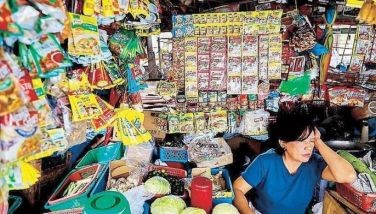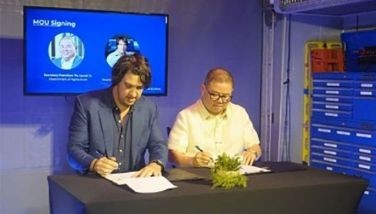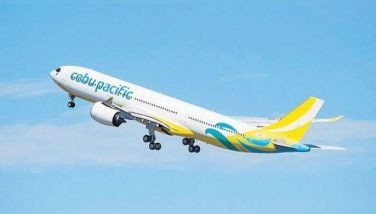What the Philippines could have been

June 26, 2002 | 12:00am
TUMON, Guam – Manuel Quezon once declared that he would rather have a government run like hell by Filipinos than a government run like heaven by Americans. Guam is not exactly heaven, but compared to us, it seems to be doing better than we are.
In a sense, Guam is what the Philippines could have been if only laws were enforced or generally taken more seriously, if scarce resources were spent a lot more efficiently building infrastructure and providing services and yes, if we had a little more control on population growth and collected our garbage.
Quezon will probably find it strange to see how efficiently Guam’s government functions when it is being run pretty much by Guamanians with strong ties to the Philippines. The system seems to work in this island. Filipinos who drive the taxis and buses here seem pretty civilized in their driving habits. It is also evident that they are respected in Guam in a way they can only dream of back home. And because of this, they have self-respect. The Pinoy is at his best, it seems, in this outpost in the vastness of the Pacific Ocean.
Of course it is hardly fair to compare Guam and the Philippines. Even if both were "discovered" by Magellan in 1521 and went through three centuries of Spanish colonial rule, followed by the Americans, the Japanese and then the Americans again, the comparison ends there.
Guam’s pretty small and as such, infinitely more manageable. In land area, Marinduque, one of our smaller major islands, is 960 square kilometers to Guam’s 549 sq. kilometers. Maybe it is more in the league of Romblon or Masbate. Its population of about 150,000 people is smaller than any of the towns and cities under the Metro Manila region. For comparison, San Juan, the smallest town in Metro Manila has a population of a little under 200,000. Even Barangay Holy Spirit in Quezon City has more than twice Guam’s population.
Despite the trappings of economic well being, Guam does not really have a thriving civilian economy. Outside of tourism, which is 90-percent dependent on the Japanese and therefore in a slump, Guam thrives because of American military spending and direct subsidy from the US Federal Treasury. Any reduction in military spending adversely affects Guam’s economy.
Right now, locals told us that they are suffering the effects of 9/11 and the worsening Japanese economy. Most of its hotel rooms are empty. Not too long ago, you couldn’t get a room without a three-month prior reservation. Because of the economic downturn, a considerable number of Guamanians have migrated to Hawaii or the mainland as the tourism industry laid off workers in droves.
There is no other real industry in Guam, no export processing zone whose production could balance the Guamanian economy’s over dependence on tourism. One of Guam’s disadvantages is its being under American laws. It must follow American minimum wage standards even if they are geographically in a region where wage levels are much lower. This is why American companies skip them for contract work and go straight to Southeast Asia including the Philippines.
Still, there is much to ohh and ahh about Guam for the Pinoys who flew in on the newly re-launched thrice a week service of Philippine Airlines to this Pacific oasis. The road infrastructure is as perfect as ours back home are unspeakably backward. Social services are adequate, based on stories told us by Pinoys who have worked and lived here for a while. And to many of our compatriots, this is as good a land of milk and honey as they ever imagined.
In fact, even to a bunch of Manila-based journalists here for the weekend, it seemed like we never left home. Tagalog is spoken everywhere. Pinoy faces everywhere you go, light up when you talk to them. Pinoys in Guam are definitely friendlier and ever ready to help a kababayan asking for directions or some fresh tips on what to do and see on the island. They have kept up with the latest in Manila via ABS-CBN’s The Filipino Channel on cable TV. They want to know when they can participate in Game KNB by texting.
A review of the history of Guam reveals that native Guamanians known today as Chamorros may have come from our part of the world. Guam’s ties with us became stronger after Magellan landed in Guam first, on his way to meet his destiny at the hands of the Cebuano, Lapu lapu. The Spaniards and later the Americans, governed Guam from Manila.
Political headaches to the colonial government in Manila were also routinely exiled to Guam by both the Spaniards and the Americans. There is a commemorative bust of Apolinario Mabini on a nice stretch of beach front in Guam. He was probably the most prominent of our national heroes exiled to Guam by the colonial powers.
Today, a new group of Filipinos, like nurses, have been flying in to Guam to take various examinations for employment in the mainland. On the other hand, Guamanians in need of medical treatment are known to prefer flying into Manila to take advantage of first world medical expertise at third world prices. It seems to me a strong revival of historically close ties between Guam and the Philippines can help both weather the economic storms of today and tomorrow.
For starters, we can learn a lot about how the Guamanians developed their tourism industry. There is nothing that they have that we don’t have back home by way of natural beauty. In fact, ours are definitely even more spectacular and breathtaking. The sea and mountain views described by hotel brochures in poetic language are beautiful alright, but nothing compared to the views in places back home such as Punta Fuego. And Mactan’s beaches (let’s not even talk Boracay or Pagudpud), win hands down compared to Guam’s.
But Guam has taken its tourism industry seriously for no other reason than it is the major industry. They have fantastic tourism infrastructure in place. And most important of all, tourists feel safe in Guam. There is a K-mart store about a mile away from our hotel and we felt safe walking back and forth to the store way past midnight. You’d be crazy to do anything like that in Manila.
Of course, it helps tremendously that the beaches of Guam are just five to 10 minutes away from the international airport. This supports my earlier suggestion that if we want to develop our tourism potential, we should bring the tourists directly to Mactan, Kalibo and maybe Bohol. Laoag is also a good tourism point to develop because of Pagudpud. That’s why tiny Guam with less physical attractions than our 7,100 islands, attract a million more tourists a year than all of the Philippines.
I am convinced that if we want to be competitive, we have to put Cebu at the center of a Philippine tourism effort. No other city can compete with the likes of Guam by way of natural and man-made entertainment. Anything a big city has, Cebu has. In addition, it has the beaches to draw that tourist dollar in. We just have to make sure peace and order is maintained at world class standards in Cebu. Stories like that Ecleo cult carnage will not help Cebu’s image.
I don’t think Dr. Ernie E is trying to suggest who’s in the driver’s seat of his car.
A man is driving with his wife at his side and his mother-in-law in the back seat. And the women just won’t leave the poor guy alone.
His mother-in-law says, "You’re driving too fast!"
His wife says, "Stay to the left!"
After several more orders from both of them the man breaks down and barks at his wife, "Who’s driving this car – you or your mother?"
(Boo Chanco’s e-mail address is [email protected])
In a sense, Guam is what the Philippines could have been if only laws were enforced or generally taken more seriously, if scarce resources were spent a lot more efficiently building infrastructure and providing services and yes, if we had a little more control on population growth and collected our garbage.
Quezon will probably find it strange to see how efficiently Guam’s government functions when it is being run pretty much by Guamanians with strong ties to the Philippines. The system seems to work in this island. Filipinos who drive the taxis and buses here seem pretty civilized in their driving habits. It is also evident that they are respected in Guam in a way they can only dream of back home. And because of this, they have self-respect. The Pinoy is at his best, it seems, in this outpost in the vastness of the Pacific Ocean.
Of course it is hardly fair to compare Guam and the Philippines. Even if both were "discovered" by Magellan in 1521 and went through three centuries of Spanish colonial rule, followed by the Americans, the Japanese and then the Americans again, the comparison ends there.
Guam’s pretty small and as such, infinitely more manageable. In land area, Marinduque, one of our smaller major islands, is 960 square kilometers to Guam’s 549 sq. kilometers. Maybe it is more in the league of Romblon or Masbate. Its population of about 150,000 people is smaller than any of the towns and cities under the Metro Manila region. For comparison, San Juan, the smallest town in Metro Manila has a population of a little under 200,000. Even Barangay Holy Spirit in Quezon City has more than twice Guam’s population.
Despite the trappings of economic well being, Guam does not really have a thriving civilian economy. Outside of tourism, which is 90-percent dependent on the Japanese and therefore in a slump, Guam thrives because of American military spending and direct subsidy from the US Federal Treasury. Any reduction in military spending adversely affects Guam’s economy.
Right now, locals told us that they are suffering the effects of 9/11 and the worsening Japanese economy. Most of its hotel rooms are empty. Not too long ago, you couldn’t get a room without a three-month prior reservation. Because of the economic downturn, a considerable number of Guamanians have migrated to Hawaii or the mainland as the tourism industry laid off workers in droves.
There is no other real industry in Guam, no export processing zone whose production could balance the Guamanian economy’s over dependence on tourism. One of Guam’s disadvantages is its being under American laws. It must follow American minimum wage standards even if they are geographically in a region where wage levels are much lower. This is why American companies skip them for contract work and go straight to Southeast Asia including the Philippines.
Still, there is much to ohh and ahh about Guam for the Pinoys who flew in on the newly re-launched thrice a week service of Philippine Airlines to this Pacific oasis. The road infrastructure is as perfect as ours back home are unspeakably backward. Social services are adequate, based on stories told us by Pinoys who have worked and lived here for a while. And to many of our compatriots, this is as good a land of milk and honey as they ever imagined.
In fact, even to a bunch of Manila-based journalists here for the weekend, it seemed like we never left home. Tagalog is spoken everywhere. Pinoy faces everywhere you go, light up when you talk to them. Pinoys in Guam are definitely friendlier and ever ready to help a kababayan asking for directions or some fresh tips on what to do and see on the island. They have kept up with the latest in Manila via ABS-CBN’s The Filipino Channel on cable TV. They want to know when they can participate in Game KNB by texting.
A review of the history of Guam reveals that native Guamanians known today as Chamorros may have come from our part of the world. Guam’s ties with us became stronger after Magellan landed in Guam first, on his way to meet his destiny at the hands of the Cebuano, Lapu lapu. The Spaniards and later the Americans, governed Guam from Manila.
Political headaches to the colonial government in Manila were also routinely exiled to Guam by both the Spaniards and the Americans. There is a commemorative bust of Apolinario Mabini on a nice stretch of beach front in Guam. He was probably the most prominent of our national heroes exiled to Guam by the colonial powers.
Today, a new group of Filipinos, like nurses, have been flying in to Guam to take various examinations for employment in the mainland. On the other hand, Guamanians in need of medical treatment are known to prefer flying into Manila to take advantage of first world medical expertise at third world prices. It seems to me a strong revival of historically close ties between Guam and the Philippines can help both weather the economic storms of today and tomorrow.
But Guam has taken its tourism industry seriously for no other reason than it is the major industry. They have fantastic tourism infrastructure in place. And most important of all, tourists feel safe in Guam. There is a K-mart store about a mile away from our hotel and we felt safe walking back and forth to the store way past midnight. You’d be crazy to do anything like that in Manila.
Of course, it helps tremendously that the beaches of Guam are just five to 10 minutes away from the international airport. This supports my earlier suggestion that if we want to develop our tourism potential, we should bring the tourists directly to Mactan, Kalibo and maybe Bohol. Laoag is also a good tourism point to develop because of Pagudpud. That’s why tiny Guam with less physical attractions than our 7,100 islands, attract a million more tourists a year than all of the Philippines.
I am convinced that if we want to be competitive, we have to put Cebu at the center of a Philippine tourism effort. No other city can compete with the likes of Guam by way of natural and man-made entertainment. Anything a big city has, Cebu has. In addition, it has the beaches to draw that tourist dollar in. We just have to make sure peace and order is maintained at world class standards in Cebu. Stories like that Ecleo cult carnage will not help Cebu’s image.
A man is driving with his wife at his side and his mother-in-law in the back seat. And the women just won’t leave the poor guy alone.
His mother-in-law says, "You’re driving too fast!"
His wife says, "Stay to the left!"
After several more orders from both of them the man breaks down and barks at his wife, "Who’s driving this car – you or your mother?"
(Boo Chanco’s e-mail address is [email protected])
BrandSpace Articles
<
>
- Latest
- Trending
Trending
Latest
Trending
Latest
Recommended






























